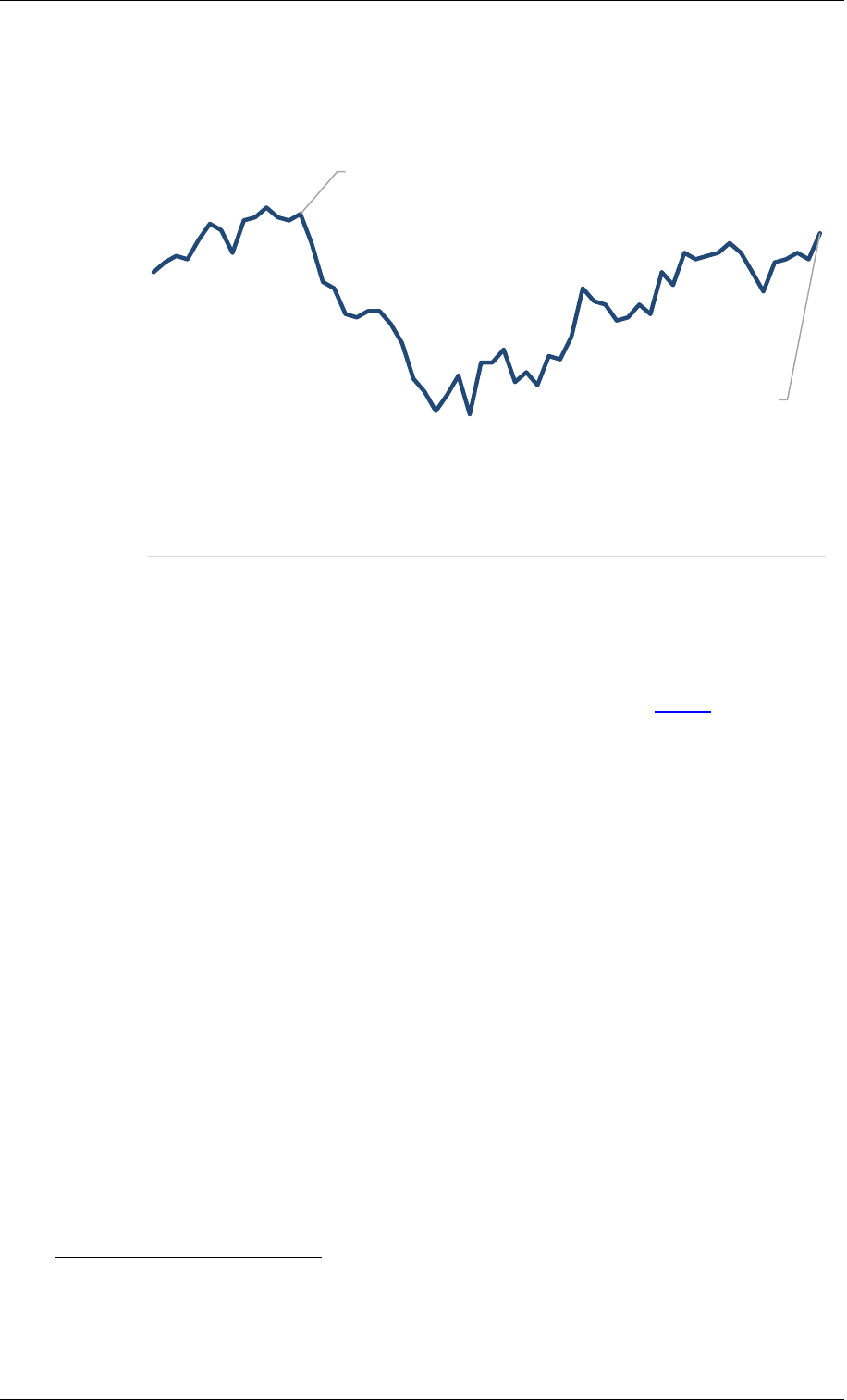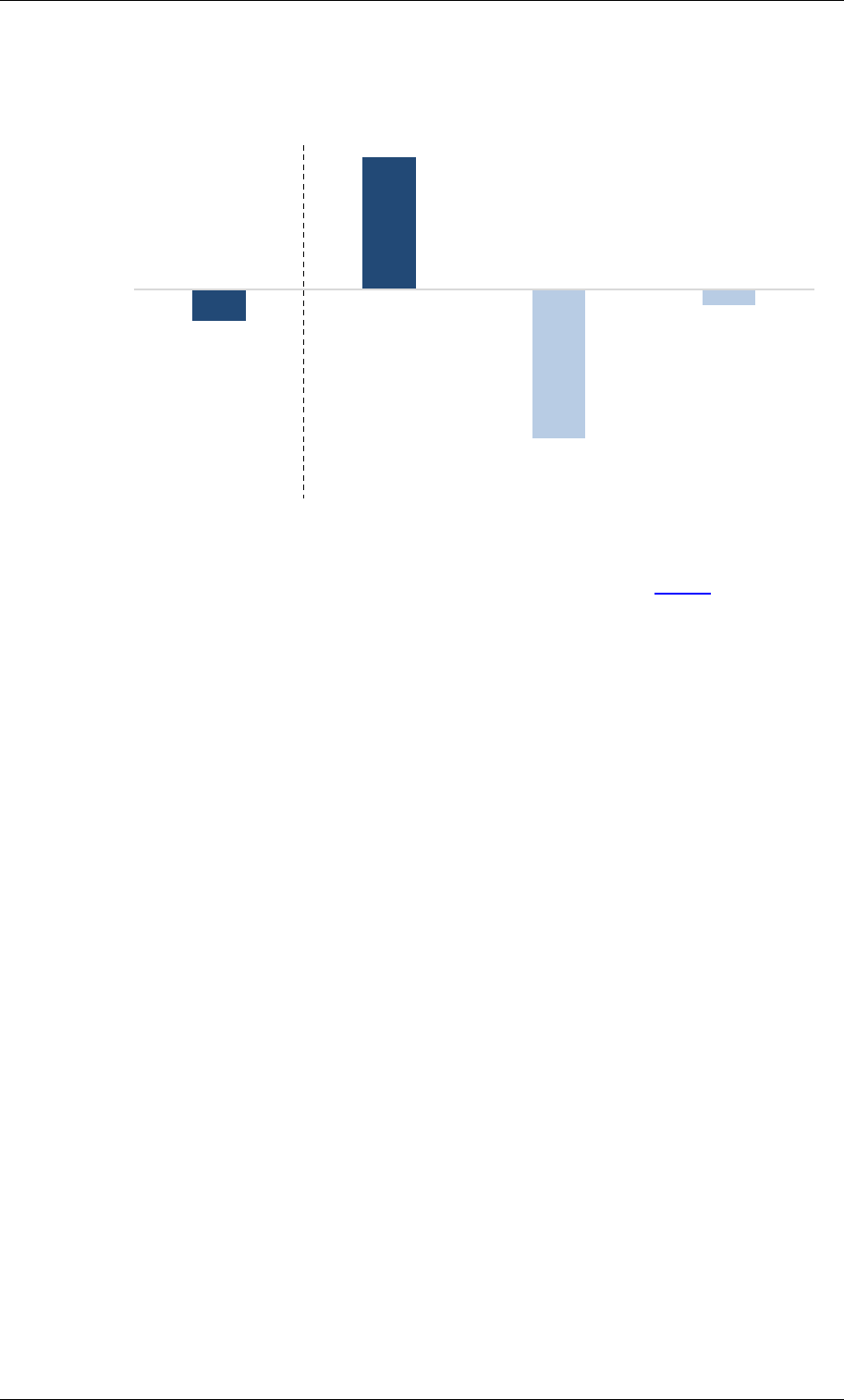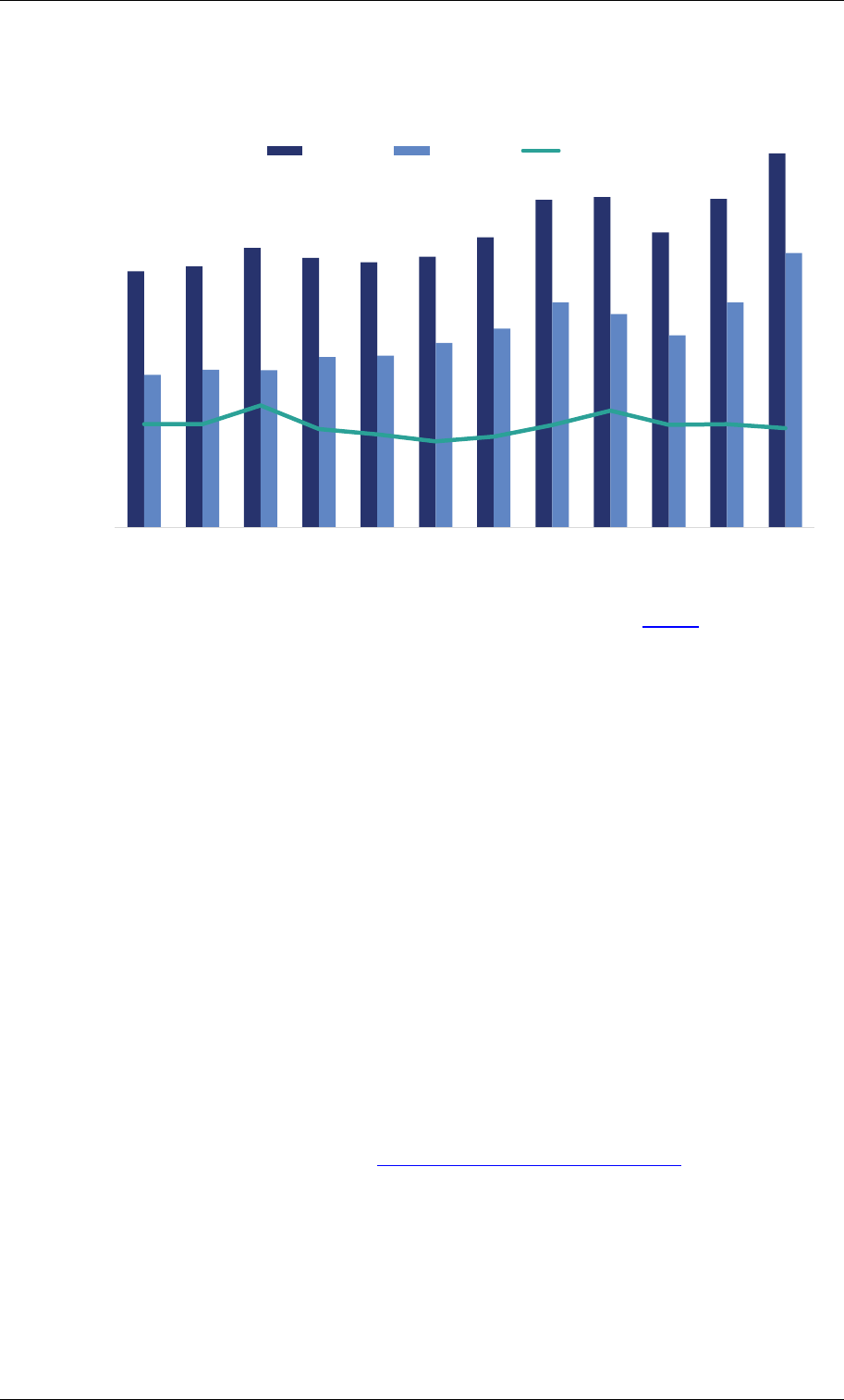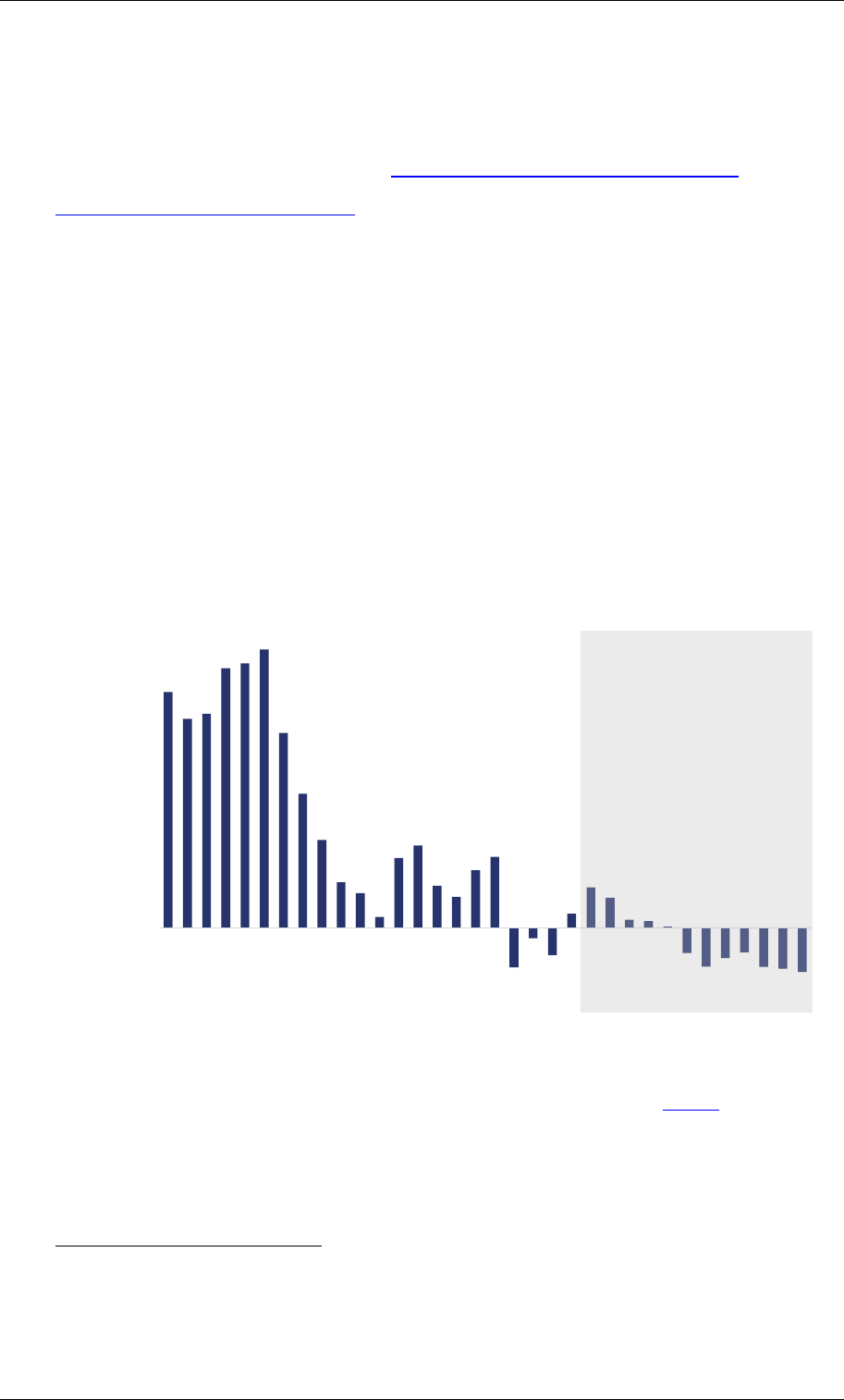
Research and Information Service
Briefing Paper
Providing research and information services to the Northern Ireland Assembly 1
Paper 03/24 1 March 2024 NIAR 123-23
Northern Ireland
economic overview
Finance and Economics Team, Research and Information Service
This Briefing Paper has been prepared for the incoming Committee for the
Economy, to provide an overview of the Northern Ireland economy as of early
March 2024. Drawing on the most recent available data, it looks at areas in
which Northern Ireland’s economy is performing well and highlights some
challenges facing it.

NIAR 123-23 Northern Ireland economic overview
Providing research and information services to the Northern Ireland Assembly 2
Key Points
Positives
Economic growth
Northern Ireland’s economy has grown 38% in real terms since the
Belfast/Good Friday Agreement was signed in 1998. During the same period,
the economies of the United Kingdom, Scotland, and Wales grew by 41%, 38%,
and 40%, respectively.
Labour market
Northern Ireland’s labour market has recovered well since the COVID-19
pandemic. Total employment (employees plus the self-employed) has almost
recovered to its pre-pandemic level. There are currently 840,000 people aged
16-64 in employment.
Furthermore, the unemployment rate is currently very low – 2.6% in the period
of October – December 2023.
Trade
Northern Ireland has been performing well in terms of its overall trade balance
(the balance of exports relative to imports). As of 2022, exports of goods and
services were at a record high of £13.3 billion (bn) – with a trade surplus of £3.5
bn.
Challenges
Inflation
Inflation remained stubbornly high over the past year and a half, peaking at
11.2% in October 2022. However, headline inflation has been on a downward
trend since then, and as of January 2024, was just 4%.
Core inflation (which excludes energy, food, alcohol and tobacco) has remained
more stubbornly high. It fell to 5.1% in January 2024 – down only slightly from
5.2% in both November and December 2023.

NIAR 123-23 Northern Ireland economic overview
Providing research and information services to the Northern Ireland Assembly 3
Economic inactivity
High economic inactivity has been a significant, long-term issue for Northern
Ireland. The headline rate has been much higher than the United Kingdom
average for decades, and has remained stubbornly high. As of December 2023,
the headline rate in Northern Ireland was 26.8% relative to 20.8% in the United
Kingdom. In relative terms, Northern Ireland is similar to the United Kingdom
average for most of these – but performs significantly worse in terms of
economic inactivity due to long-term sick or disabled.
Productivity
Northern Ireland’s productivity gap when compared to the United Kingdom
average is another long-running economic issue. Key productivity metrics for
Northern Ireland have been persistently and consistently below the United
Kingdom average over the past two decades.
Labour Supply
A potential challenge faced by the Northern Ireland economy is weak labour
supply growth. This is a combination of low growth in working age population
and net migration.
Inclusion
Inclusion (in terms of how economic growth and opportunities are distributed
across society) are below acceptable levels in a number of metrics in Northern
Ireland. For example, employment rates for disabled people in Northern Ireland
are much lower than those for non-disabled people; and are far below the
United Kingdom average. Employment rates for the most deprived areas in
Northern Ireland are also significantly lower than those in the least deprived
areas, and the Northern Ireland average.

NIAR 123-23 Northern Ireland economic overview
Providing research and information services to the Northern Ireland Assembly 4
Introduction
This Briefing Paper has been prepared for the incoming Committee for the
Economy (CfE) (the Committee), to provide an overview of the Northern Ireland
economy as of March 2024. Drawing on the most recent available data,
1
it looks
at areas in which Northern Ireland’s economy is performing well and highlights
some challenges facing it. In particular, it addresses employment,
unemployment, trade balance and ongoing economic challenges, such as
Northern Ireland’s productivity gap, economic inactivity, inflation and inclusion.
The Paper is presented as follows:
• Section 1 – Context-setting;
• Section 2 – Positives – areas in which the Northern Ireland economy is
performing well;
• Section 3 – Challenges – key challenges facing Northern Ireland’s
decision makers; and,
• Section 4 – Key takeaways.
The Paper is not intended to address the specific circumstances of any
particular individual. It should not be relied upon as professional legal advice or
as a substitute for it.
1
All data referenced in this paper was current as of 1 March 2024.

NIAR 123-23 Northern Ireland economic overview
Providing research and information services to the Northern Ireland Assembly 5
1 Context setting
Prior to outlining Northern Ireland’s current economic outlook, this section
provides context in terms of key findings arising from the outgoing Committee
for the Economy’s micro inquiry on Northern Ireland’s economic context (sub-
section 1.1) and existing Department for the Economy (DfE) policies (sub-
section 1.2).
1.1 Micro Inquiry – Economic Outlook
In autumn 2020, the former Committee undertook an Economic Outlook Micro
Inquiry; aiming to engage with key stakeholders, seek their views and thereafter
develop a themes-based report providing evidence on how the economy has
been impacted as a result of the COVID-19 pandemic and ideas on how to
rebuild it better.
In November 2020, the Committee held a discussion event with a wide range of
stakeholders including Chambers of Commerce, business and industry
representatives and economists.
Thereafter, it published a summation of the key themes arising from the micro
inquiry, which stakeholders had felt were necessary to rebuild and boost the
economy, including: technology and digital infrastructure; skills and
employment; transport infrastructure; and, energy for businesses and
consumers.
1.2 Relevant DfE policies
There are a number of policies, strategies and action plans currently published
by DfE that are relevant to the areas discussed in sections 2 and 3 of this
Paper. These include the 10X Economy, and its associated delivery plan – a
strategy which focuses on innovation and productivity growth; and building on
Northern Irelands economic strengths.
In particular, DfE’s Skills Strategy for Northern Ireland (Skills for a 10X
economy) sets a strategic framework for the development of Northern Ireland’s

NIAR 123-23 Northern Ireland economic overview
Providing research and information services to the Northern Ireland Assembly 6
skills system to 2030 – with a view to supporting the successful delivery of the
10X Economy.
The Trade and investment for a 10X Economy publication outlines the strategic
priorities and high level ambitions that will shape DfE’s approach to trade and
investment; and DfE’s Energy Strategy, Path to Net Zero Energy sets out a
pathway for energy to 2030 that will “mobilise the skills, technologies and
behaviours needed to take us towards our vision of net zero carbon and
affordable energy by 2050”.
2 Positives
Drawing on the most recent available data, this section looks at areas in which
Northern Ireland’s economy is performing well:
2.1 Economic growth;
2.2 Labour market; and,
2.3 Trade.
2.1 Economic growth
Northern Ireland’s Gross Domestic Product (GDP) (a measure of the value of
the goods and services produced in a country or region – which estimates the
size and growth of the economy) has grown 38% in real terms since the
Belfast/Good Friday Agreement was signed in 1998. During the same period,
the economies of the United Kingdom, Scotland, and Wales grew by 41%, 38%,
and 40%, respectively, as highlighted in Figure 1 below:

NIAR 123-23 Northern Ireland economic overview
Providing research and information services to the Northern Ireland Assembly 7
Figure 1: GDP growth, Northern Ireland & United Kingdom, 1998-2021,
(2019 prices)
Source: ONS, April 2023
2.2 Labour market
This sub-section briefly outlines the performance of Northern Ireland’s labour
market in two key metrics: employment; and, unemployment.
2.2.1 Employment
Northern Ireland’s labour market has recovered well since the COVID-19
pandemic. As Figure 2 below shows, total employment (of those aged 16-64)
has almost recovered to its pre-pandemic level:
138.1
141.1
60
70
80
90
100
110
120
130
140
150
160
NI UK
1998=100

NIAR 123-23 Northern Ireland economic overview
Providing research and information services to the Northern Ireland Assembly 8
Figure 2: Total employment (age 16-64), Northern Ireland, Jan 2019 – Dec
2023
Source: NISRA, February 2024
However, this aggregate performance conceals a wide variation in the
composition of employment in Northern Ireland.
Total employment (of those aged 16+)
2
is slightly below its pre-pandemic level
(in the period of December 2019-February 2020). This is because a large
increase in the number of employees has been more than offset by a fall in the
number of self-employed people during the same time period. The “other”
category includes those on government training schemes and unpaid family
workers. This is shown in Figure 3 below:
2
Statistics on the composition of employment (employees, self-employed, and “other”) are available
only for those aged 16+; whereas headline figures for employment and employment rates are
typically stated in terms of those aged 16-64.
Pre-pandemic
846k
Current
840k
740
760
780
800
820
840
860
Nov-Jan 19
Jan-Mar 19
Mar-May 19
May-Jul 19
Jul-Sep 19
Sep-Nov 19
Nov-Jan 20
Jan-Mar 20
Mar-May 20
May-Jul 20
Jul-Sep 20
Sep-Nov 20
Nov-Jan 21
Jan-Mar 21
Mar-May 21
May-Jul 21
Jul-Sep 21
Sep-Nov 21
Nov-Jan 22
Jan-Mar 22
Mar-May 22
May-Jul 22
Jul-Sep 22
Sep-Nov 22
Nov-Jan 23
Jan-Mar 23
Mar-May 23
May-Jul 23
Jul-Sep 23
Sep-Nov 23
Total employment (000s)

NIAR 123-23 Northern Ireland economic overview
Providing research and information services to the Northern Ireland Assembly 9
Figure 3: Drivers of employment change (age 16+), Feb 2020 – Dec 2023
Source: NISRA, February 2024
2.2.2 Unemployment
In addition to high employment levels, the unemployment rate in Northern
Ireland is now at a near-historic low. The rate in the period of October-
December 2023 was just 2.6% – below the United Kingdom average of 4.2% –
as shown in Figure 4 below. Whilst this is a positive in the economic narrative, it
also reflects the fact that there are large numbers of people in Northern Ireland
classified as economically inactive. Therefore, whilst they do not count as
unemployed, they are outside the labour market altogether (see subsection
3.2):
-6,000
+25,000
-28,000
-3,000
-40,000
-30,000
-20,000
-10,000
0
10,000
20,000
30,000
Employment Employees Self Employed Other

NIAR 123-23 Northern Ireland economic overview
Providing research and information services to the Northern Ireland Assembly 10
Figure 4: Unemployment rate (age 16+), Northern Ireland and UK, Jan 2010
– Dec 2023
Source: ONS, NISRA, February 2024
2.3 Trade
Northern Ireland has also been performing well in terms of its overall trade
balance (the balance of exports relative to imports). As of 2022, exports of
goods and services are at a record high of £13.3 bn – with a trade surplus of
£3.5 bn – as highlighted in Figure 5 below:
3
3
NISRA trade values are published in current prices, and therefore do not include the effects of
inflation over time.
2.6%
4.2%
0%
1%
2%
3%
4%
5%
6%
7%
8%
9%
Unemployment rate (%)
NI UK

NIAR 123-23 Northern Ireland economic overview
Providing research and information services to the Northern Ireland Assembly 11
Figure 5: Northern Ireland exports, imports & trade balance, 2011-2022
Source: NISRA, December 2023
3 Challenges
This section focuses on some of the key challenges facing Northern Ireland’s
economy. These include: above-target inflation; persistently high economic
inactivity; lower productivity than the United Kingdom average; potentially weak
labour supply growth; and, poor inclusion performance.
3.1 Inflation
Consumer Price Inflation (CPI) remained high over the past year, staying above
10% for the nine months between July 2022 and March 2023; peaking at 11.2%
in October 2022. However, headline inflation has been on a downward trend
since then. It was 4% in January 2024 – unchanged from December 2023.
Whilst this is still higher than the Bank of England’s target of 2%, it is nearly
three times lower than it was in October 2022.
The biggest contributors to January’s 4% headline rate of CPI inflation were:
restaurants and hotels (1%) food and non-alcoholic drinks (0.8%) and
recreation and culture (0.8%), as illustrated in Figure 6 below:
3.7
3.7
4.3
3.5
3.3
3.1
3.2
3.7
4.2
3.7
3.7
3.5
0
2
4
6
8
10
12
14
2011 2012 2013 2014 2015 2016 2017 2018 2019 2020 2021 2022
Trade values (£ billion)
Exports Imports Trade balance

NIAR 123-23 Northern Ireland economic overview
Providing research and information services to the Northern Ireland Assembly 12
Figure 6: Components of CPI inflation, January 2024
Source: ONS, February 2024
Core inflation (which excludes energy, food, alcohol and tobacco) has remained
more stubbornly high. It was 5.1% in January 2024 – down only slightly from
5.2% in December 2023.
It is worth noting that whilst inflation is falling, that does not mean price levels
are falling. In fact, they are still increasing, but at a slower rate of increase.
Figure 7 below illustrates this:

NIAR 123-23 Northern Ireland economic overview
Providing research and information services to the Northern Ireland Assembly 13
Figure 7: CPI and “core” inflation, Jan 2019 – Jan 2024
Source: ONS, February 2024
3.2 Economic inactivity
High economic inactivity has been a significant, long-term issue for Northern
Ireland. The headline rate has been much higher than the United Kingdom
average for decades, and has remained stubbornly high. As of December 2023,
the headline rate in Northern Ireland was 26.8% relative to 20.8% in the United
Kingdom. Figure 8 below highlights this:
4.0%
5.1%
0%
2%
4%
6%
8%
10%
12%
Inflation rate 9%)
CPI Core (excl. energy, food, alcohol & tobacco)

NIAR 123-23 Northern Ireland economic overview
Providing research and information services to the Northern Ireland Assembly 14
Figure 8: Economic inactivity rate, Northern Ireland & United Kingdom,
Jan 2010 – December 2023
Source: ONS, NISRA, January 2024
There are a number of reasons for economic inactivity among the working age
population in Northern Ireland (such as retirement, student status, carers for
relatives, long-term sickness and disability). In relative terms, Northern Ireland
is similar to the United Kingdom average for most of these – but performs
significantly worse in terms of economic inactivity due to being long-term sick or
disabled. Long-term sick and disabled accounts for 41% of total inactivity in
Northern Ireland, as opposed to just 30% in the United Kingdom.
26.8%
20.8%
15%
17%
19%
21%
23%
25%
27%
29%
31%
Nov-Jan 10
May-Jul 10
Nov-Jan 11
May-Jul 11
Nov-Jan 12
May-Jul 12
Nov-Jan 13
May-Jul 13
Nov-Jan 14
May-Jul 14
Nov-Jan 15
May-Jul 15
Nov-Jan 16
May-Jul 16
Nov-Jan 17
May-Jul 17
Nov-Jan 18
May-Jul 18
Nov-Jan 19
May-Jul 19
Nov-Jan 20
May-Jul 20
Nov-Jan 21
May-Jul 21
Nov-Jan 22
May-Jul 22
Nov-Jan 23
May-Jul 23
Inactivity rate (%)
NI UK

NIAR 123-23 Northern Ireland economic overview
Providing research and information services to the Northern Ireland Assembly 15
Potential scrutiny point:
1) How will the Executive/departments address the persistently
high levels of economic inactivity? In particular, what
practical steps will they take to reduce the proportion of
long-term sick and disabled in Northern Ireland relative to
the United Kingdom average?
3.3 Productivity gap
Northern Ireland’s productivity gap to the United Kingdom average is another
long-running economic issue. Key productivity metrics have been persistently
below the United Kingdom average over the past two decades. Currently, as
illustrated in Figure 9 below: GDP per capita (20% gap); GDP per filled job
(10% gap); and GDP per hour worked (12% gap):
Figure 9: Productivity measures, Northern Ireland vs. United Kingdom,
2004-2021
Source: ONS, June 2023
70%
75%
80%
85%
90%
95%
100%
2004
2005
2006
2007
2008
2009
2010
2011
2012
2013
2014
2015
2016
2017
2018
2019
2020
2021
Relative to the UK
GDP per capita GDP per filled job GDP per hour worked
UK = 100%

NIAR 123-23 Northern Ireland economic overview
Providing research and information services to the Northern Ireland Assembly 16
The productivity gap highlighted at Figure 9 is a result of a combination of two
things:
1. The sectoral mix of the Northern Ireland economy – more reliance on
lower-productivity sectors relative to the United Kingdom average; and
2. Productivity differences within sectors – for example, lower
productivity in the financial services sector in Northern Ireland relative to
the United Kingdom average in the same sector (which itself could be
caused by a number of factors, including poor management
performance).
In other words, the productivity gap is due to a combination of what Northern
Ireland does; and how it does it. It should be noted that there are lots of
potential reasons for lower productivity – for example, the second (“how it does
it”) category, could include human capital, lack of research and development,
etc. Estimating the extent to which each of these factors contributes to Northern
Ireland’s productivity gap requires further research.
Potential scrutiny point(s):
2) What areas will the Executive or the DfE focus on to close
the productivity gap? When will that happen? If not, please
detail why not.
3) When seeking to do that, what balance will they strike
between attracting investment in higher productivity sectors
versus investing in management and upskilling?
4) What type/size of firms will government support focus most
on?

NIAR 123-23 Northern Ireland economic overview
Providing research and information services to the Northern Ireland Assembly 17
3.4 Labour supply
A potential challenge faced by the Northern Ireland economy is weak labour
supply growth – an issue noted in Ulster University’s Competitiveness
Scorecard for Northern Ireland.
4
This is a combination of low growth in working
age population (internal) and net migration (external).
3.4.1 Internal labour supply
Growth in Northern Ireland’s working age population has been weak in the last
decade. Moreover, according to Northern Ireland Statistics and Research
Agency (NISRA) estimates, growth for that group is anticipated to be flat from
2026, and negative from 2029 onwards.
5
That means the working age
population will decrease after 2029, as highlighted in Figure 10 below:
Figure 10: Working age population growth, Northern Ireland, 2002-2035
Source: NISRA, January 2022
4
Section 5.4.3
5
The ONS notes that national population projections are not forecasts and do not attempt to predict
potential changes in international migration.
-0.4%
-0.2%
0.0%
0.2%
0.4%
0.6%
0.8%
1.0%
1.2%
1.4%
2002 2005 2008 2011 2014 2017 2020 2023 2026 2029 2032 2035
Working age population growth (%)
Forecast

NIAR 123-23 Northern Ireland economic overview
Providing research and information services to the Northern Ireland Assembly 18
3.4.2 External labour supply
It should be noted that when a working age population is not growing – that is,
staying the same or contracting – additional reliance is placed on migration for
future labour supply. That trend presents a challenge for Northern Ireland when
considered in the context of inward migration from the United Kingdom and
internationally in recent years, which has been somewhat limited. Existing and
potential future immigration rules in the United Kingdom also could have
implications for labour supply growth in Northern Ireland. Figure 11 below
highlights the trend from 2002-2022:
Figure 11: Northern Ireland net migration, UK & Rest of world, 2002-2022
Source: NISRA, August 2023
3.5 Inclusion
There are other long-running challenges facing the Northern Ireland economy,
which are worth noting. Inclusion is one of them; defined by the OECD as
“…economic growth that is distributed fairly across society and creates
opportunities for all…”. It is below acceptable levels in a number of metrics in
Northern Ireland. For example, employment rates for disabled people in
Northern Ireland are much lower than those for non-disabled people; and are far
below the United Kingdom average.
-6,000
-4,000
-2,000
0
2,000
4,000
6,000
8,000
10,000
12,000
2002 2004 2006 2008 2010 2012 2014 2016 2018 2020 2022
Net migration
UK International Total

NIAR 123-23 Northern Ireland economic overview
Providing research and information services to the Northern Ireland Assembly 19
The employment rate for disabled people in Northern Ireland in 2021 was just
37.3%, compared with 79.6% for non-disabled people. The equivalent disabled
employment rate in the United Kingdom in 2021 was 53%. Figure 12 below
highlights this:
Figure 12: Employment rate, Northern Ireland, disabled & non-disabled,
2014-2021
Source: NISRA, October 2023
Making improvements in this area would have positive implications from
economic, social, and health perspectives. However, to illustrate the scale of
the challenge, if the gap in employment rate for disabled to the non-disabled in
Northern Ireland was halved (making it similar to the United Kingdom average),
there would be more than 40,000 more disabled people in employment in
Northern Ireland. At the average productivity level, this additional employment
would be equivalent to around 5% of Northern Ireland’s GDP.
Employment rates for the most deprived areas in Northern Ireland are also
significantly lower than those in the least deprived areas, and the Northern
Ireland average. In 2021, the rate in the most deprived areas was 56.1% -
compared with a regional average of 70.2%, and a rate in the least deprived
areas of 77.6%.
37.3%
79.6%
0%
10%
20%
30%
40%
50%
60%
70%
80%
90%
2014 2015 2016 2017 2018 2019 2020 2021
Employment rate (%)
Disabled Non-disabled

NIAR 123-23 Northern Ireland economic overview
Providing research and information services to the Northern Ireland Assembly 20
For illustrative purposes, if the employment rate in Northern Ireland’s most
deprived areas was increased to match the Northern Ireland average, there
would be almost 29,000 more people in employment – equivalent to more than
3% of Northern Ireland’s GDP, as Figure 13 shows:
Figure 13: Employment rate, Northern Ireland, most deprived & least
deprived areas, 2014-2021
Source: NISRA, October 2023
Potential scrutiny point:
5) What steps will the Executive and the DfE take to reduce the
employment rate gap for those in Northern Ireland’s most
deprived areas; and those with a disability?
70.2%
56.1%
77.6%
40%
45%
50%
55%
60%
65%
70%
75%
80%
85%
2014 2015 2016 2017 2018 2019 2020 2021
NI average Most deprived Least deprived

NIAR 123-23 Northern Ireland economic overview
Providing research and information services to the Northern Ireland Assembly 21
4 Key takeaways
Northern Ireland's economy has been performing well on a number of important
measures: the economy has grown 38% in real terms since the signing of the
Belfast/Good Friday Agreement in 1998; employment levels have almost
returned to pre-pandemic levels; the unemployment rate is at a near-historic
low; and, exports are at record high levels.
However, those positives are offset by some significant challenges – both in the
immediate and longer terms. For example, the persistence of high inflation over
the past year has put pressure on businesses and consumers; and whilst it has
fallen from its peak in late 2022, it still remains above the Bank of England’s 2%
target.
Moreover, the high rate of economic inactivity remains one of Northern Ireland’s
most significant challenges, despite record low unemployment. Specifically, the
proportion of economically inactive working age adults that are long-term sick or
disabled is much higher than the United Kingdom average.
Additionally, persistently low productivity, weak labour supply growth and poor
inclusion performance in terms of disability and deprivation all need addressed.
This Paper – drawing on most recent available data – provides an update for
the incoming CfE on key aspects of the Northern Ireland economy and potential
scrutiny points, which could help to inform the Committee’s deliberations when
formulating its forward work plans and when engaging in future with the DfE and
other stakeholders. In particular, it has noted some of the areas in which
Northern Ireland’s economy has been performing well – including: the economy
growing almost 40% since the Belfast/Good Friday agreement was signed; total
employment surpassing its pre-pandemic peak; historic low unemployment
rates; and export values at a record high level. It has also outlined some of the
key challenges facing Northern Ireland’s economy. Those include: above-target
inflation; persistently high economic inactivity; lower productivity than the United
Kingdom average; potentially weak labour supply growth; and, poor inclusion
performance.
